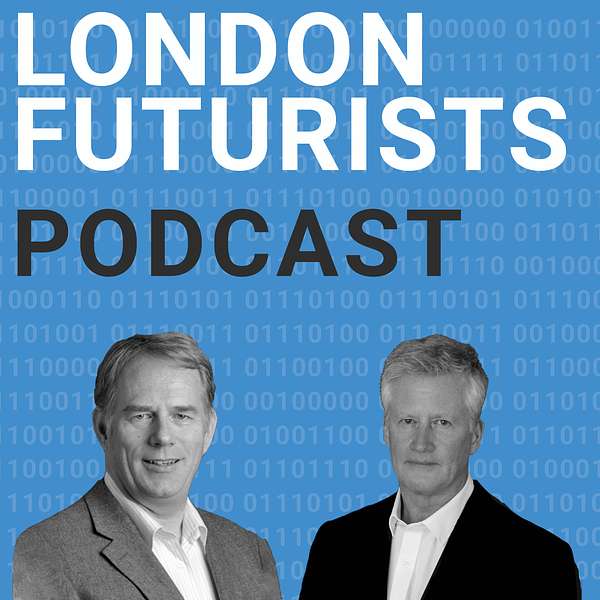
London Futurists
Anticipating and managing exponential impact - hosts David Wood and Calum Chace
Calum Chace is a sought-after keynote speaker and best-selling writer on artificial intelligence. He focuses on the medium- and long-term impact of AI on all of us, our societies and our economies. He advises companies and governments on AI policy.
His non-fiction books on AI are Surviving AI, about superintelligence, and The Economic Singularity, about the future of jobs. Both are now in their third editions.
He also wrote Pandora's Brain and Pandora’s Oracle, a pair of techno-thrillers about the first superintelligence. He is a regular contributor to magazines, newspapers, and radio.
In the last decade, Calum has given over 150 talks in 20 countries on six continents. Videos of his talks, and lots of other materials are available at https://calumchace.com/.
He is co-founder of a think tank focused on the future of jobs, called the Economic Singularity Foundation. The Foundation has published Stories from 2045, a collection of short stories written by its members.
Before becoming a full-time writer and speaker, Calum had a 30-year career in journalism and in business, as a marketer, a strategy consultant and a CEO. He studied philosophy, politics, and economics at Oxford University, which confirmed his suspicion that science fiction is actually philosophy in fancy dress.
David Wood is Chair of London Futurists, and is the author or lead editor of twelve books about the future, including The Singularity Principles, Vital Foresight, The Abolition of Aging, Smartphones and Beyond, and Sustainable Superabundance.
He is also principal of the independent futurist consultancy and publisher Delta Wisdom, executive director of the Longevity Escape Velocity (LEV) Foundation, Foresight Advisor at SingularityNET, and a board director at the IEET (Institute for Ethics and Emerging Technologies). He regularly gives keynote talks around the world on how to prepare for radical disruption. See https://deltawisdom.com/.
As a pioneer of the mobile computing and smartphone industry, he co-founded Symbian in 1998. By 2012, software written by his teams had been included as the operating system on 500 million smartphones.
From 2010 to 2013, he was Technology Planning Lead (CTO) of Accenture Mobility, where he also co-led Accenture’s Mobility Health business initiative.
Has an MA in Mathematics from Cambridge, where he also undertook doctoral research in the Philosophy of Science, and a DSc from the University of Westminster.
London Futurists
The terabrain is near, with Simon Thorpe
Why do human brains consume much less power than artificial neural networks? Simon Thorpe, Research Director of CNRS, explains his view that the key to artificial general intelligence is a "terabrain" that copies from human brains the sparse-firing networks with spiking neurons.
00.11 Recapping "the AI paradox"
00.28 The nervousness of CTOs regarding AI
00.43 Introducing Simon
01.43 45 years since Oxford, working out how the brain does amazing things
02.45 Brain visual perception as feed-forward vs. feedback
03.40 The ideas behind the system that performed so well in the 2012 ImageNet challenge
04.20 The role of prompts to alter perception
05.30 Drawbacks of human perceptual expectations
06.05 The video of a gorilla on the basketball court
06.50 Conjuring tricks and distractions
07.10 Energy consumption: human neurons vs. artificial neurons
07.26 The standard model would need 500 petaflops
08.40 Exaflop computing has just arrived
08.50 30 MW vs. 20 W (less than a lightbulb)
09.34 Companies working on low-power computing systems
09.48 Power requirements for edge computing
10.10 The need for 86,000 neuromorphic chips?
10.25 Dense activation of neurons vs. sparse activation
10.58 Real brains are event driven
11.16 Real neurons send spikes not floating point numbers
11.55 SpikeNET by Arnaud Delorme
12.50 Why are sparse networks studied so little?
14.40 A recent debate with Yann LeCun of Facebook and Bill Dally of Nvidia
15.40 One spike can contain many bits of information
16.24 Revisiting an experiment with eels from 1927 (Lord Edgar Adrian)
17.06 Biology just needs one spike
17.50 Chips moved from floating point to fixed point
19.25 Other mentions of sparse systems - MoE (Mixture of Experts)
19.50 Sparse systems are easier to interpret
20.30 Advocacy for "grandmother cells"
21.23 Chicks that imprinted on yellow boots
22.35 A semantic web in the 1960s
22.50 The Mozart cell
23.02 An expert system implemented in a neural network with spiking neurons
23.14 Power consumption reduced by a factor of one million
23.40 Experimental progress
23.53 Dedicated silicon: Spikenet Technology, acquired by BrainChip
24.18 The Terabrain Project, using standard off-the-shelf hardware
24.40 Impressive recent simulations on GPUs and on a MacBook Pro
26.26 A homegrown learning rule
26.44 Experiments with "frozen noise"
27.28 Anticipating emulating an entire human brain on a Mac Studio M1 Ultra
28.25 The likely impact of these ideas
29.00 This software will be given away
29.17 Anticipating "local learning" without the results being sent to Big Tech
30.40 GPT-3 could run on your phone next year
31.12 Our interview next year might be, not with Simon, but with his Terabrain
31.22 Our phones know us better than our spouses do
Simon's academic page: https://cerco.cnrs.fr/page-perso-simon-thorpe/
Simon's personal blog: https://simonthorpesideas.blogspot.com/
Audio engineering by Alexander Chace.
Music: Spike Protein, by Koi Discovery, available under CC0 1.0 Public Domain Declaration
Interviews with Tech Leaders and insights on the latest emerging technology trends.
Listen on: Apple Podcasts Spotify

